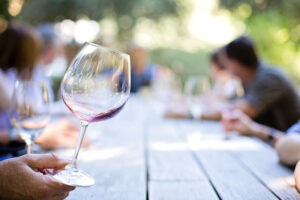This article is all about hosting a delightful and memorable Wine Tasting Party that will have your guests swirling, sniffing, and sipping their way to a new appreciation of wines. Whether you’re a seasoned sommelier or just someone who enjoys a good glass of vino, we’ve got you covered with tips and tricks to make your event a success.
Before to start:
- Be sure to have enough wine glasses for each guest to taste 2 wines side-by-side
- Serve wines in a well-lit room without too many distractions
- A white background helps see the color
- Wine Info Print-Outs: Print out the technical information of each wine (usually available on the producer’s website). This info will come in very handy during the tasting when people start asking questions. And believe me, they will.
- How much wine to serve? A standard tasting pour is about half the size of a regular serving, at around 2–3 ounces (75–90 ml), and a bottle of wine contains about 10 taste servings. You might decide to have a little leftover just in case. For a party of 8–10 plan on buying 2 bottles of each wine.
- Start With an Aperitif: It seems odd to serve wine before a wine tasting, but it makes sense. Just a splash of some sparkling wine or a simple wine cocktail will relax your guests and get them into the spirit of the tasting. They also will be less inclined to hover over you while you’re getting everything ready.
A note on odors: Keep the tasting area as neutral smelling as possible.A wine will taste like bacon if the room smells of it.
Supplies you need:
- Wine
- Wine Opener
- Identical Wine Glasses
- Water
- Napkins
- Wine Tasting Placemat
- Palate Cleanser (water crackers)
- Dump Bucket
- Polishing cloth
- Decanter (for bold reds)
- Wine bags (for blind tasting)
1. Selecting the Wines
Start by choosing a variety of wines from different regions and grape varieties. Aim for a mix of reds, whites, and perhaps a rosé or sparkling wine. Include a range of styles from light to full-bodied. Wine tastings that have a common theme are more educational and entertaining. Also, creating a theme will help you plan smarter. A wine tasting theme will focus on choosing the exact wines for your tasting. Here some of classic themes to get you started:
- A single grape from 2 regions
- A single wine from the same region by different producers
- A single wine from different vintages
Remember: wine tasting order is very important! From light and delicate to dark and rich 🙂
2. Invitations and Decor
Create invitations that set the tone for your wine tasting soirée. Consider elegant and wine-themed designs. Set up your space with tasteful decorations – think wine barrels, cork centerpieces, and grapevine wreaths. Dim lighting and soft music can be added to the ambiance.
3. Setting Up The Tasting
Before guests arrive you’ll want to set aside some time to prepare your space. First of all, decant any bold red wines that need air. Then set the table, organize your appetizer display and, finally, get your aperitif wine ready (your party’s “ice breaker” wine) as your guests start to arrive.
4. Tasting Notes and Scorecards
Provide guests with tasting notes and scorecards to help them record their impressions of each wine. Include space for appearance, aroma, taste, and overall rating. This adds an interactive and educational element to the party.
5. The Tasting Process
Guide your guests through the tasting process. Start with the lightest wines and progress to the heavier ones. Encourage everyone to observe the wine’s color, swirl it to release its aromas, take a deep sniff, and finally, savor the taste.
Stagger Wine Service: If you stagger pouring the wines into 15 minute intervals, people will take longer to analyze and get involved taking notes about each wine.
6. Food Pairings
Enhance the tasting experience by offering a variety of food pairings that complement the wines. Consider cheeses, charcuterie, fruits, nuts, and even some chocolate for dessert. A well-curated spread can elevate the flavors of both the wines and the food.
7. Educational Element
If you’re a wine connoisseur or can invite one, consider having a brief educational session about wine regions, grape varieties, and wine-making techniques. This adds an informative layer to the event and allows guests to expand their knowledge.
8. Blind Tasting Challenge
For some added excitement, consider a blind tasting challenge. Cover the bottles with bags and have guests guess the wine’s type, region, and other characteristics. It’s a fun way to test their wine knowledge.
9. Party Favors
Send your guests home with a small party favor, perhaps a wine stopper, a wine charm, or a mini bottle of wine. It’s a thoughtful gesture that adds a final touch to the event.
Remember, the key to a successful wine tasting party is to create an inviting and relaxed atmosphere where everyone feels comfortable expressing their opinions and learning from each other. So, gather your friends and loved ones, uncork those bottles, and let the wine flow as you enjoy a night filled with laughter, good company, and the joy of discovering new flavors.
Cheers to a delightful and unforgettable wine tasting experience!
Sip, savor, and enjoy 🙂
